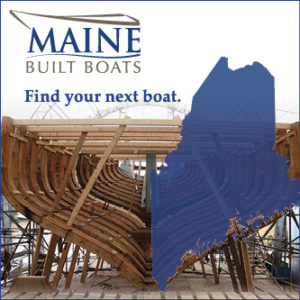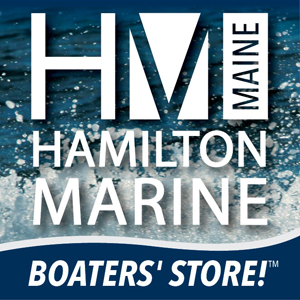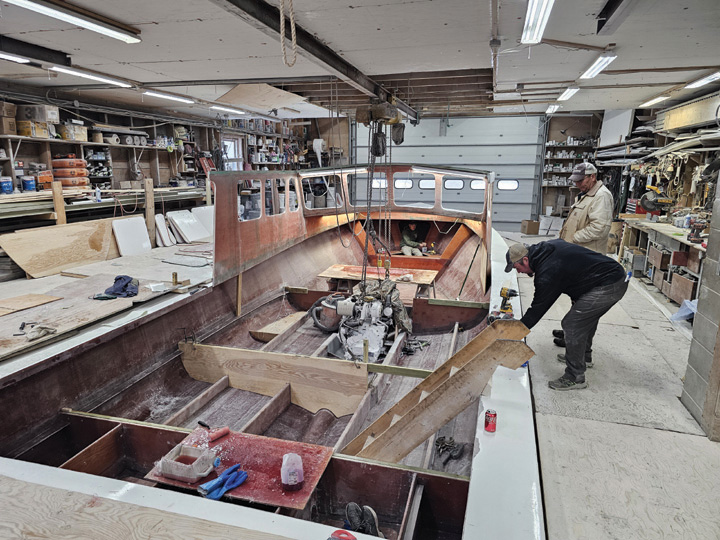
This Calvin Beal 36 is being finished off by Little River Boat Shop in Cutler for a lobster fisherman from Cutler. This boat will be finished the end of March.
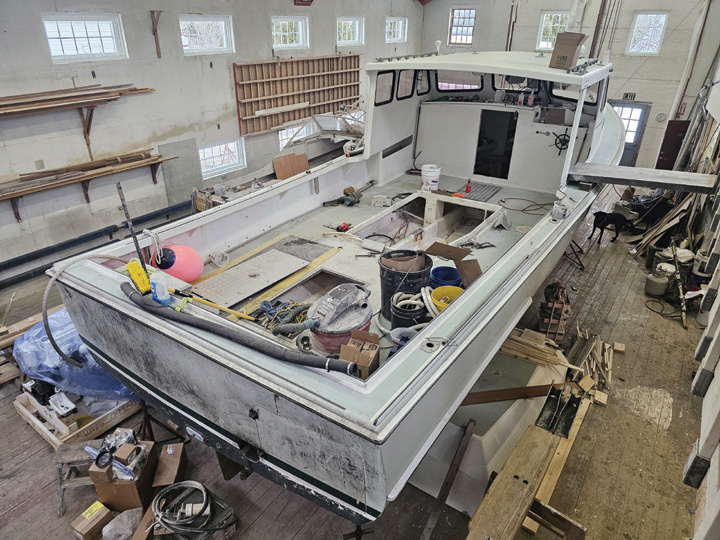
This is a power boat to be repowered at Finestkind Boat Yard in Harpswell.
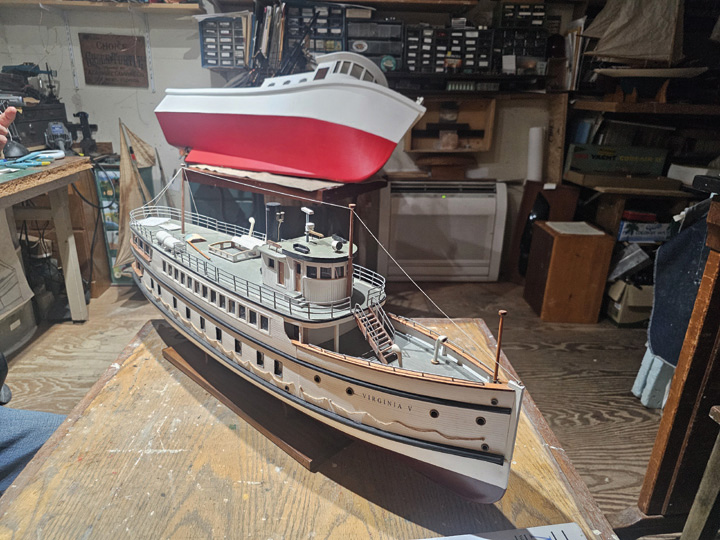
At Jerome Morris’ model shop he is making repairs to the steamer VIRGINIA V and a southern shrimper.
Eric Dow, Boatbuilder – Brooklin
An interesting project is the repairs being done on the power boat MADDIE SUE, which was built by Chester Clements of Southwest Harbor in 1932. I first heard about MADDIE SUE from Richard Stanley, who talked about several people who were interested in rebuilding her, one of which was Eric Dow. The talk about this project continued until I found her at Eric’s shop last fall. The owner did not want a major restoration, but did want her repaired so that she was sound. Eric said that they tried to keep it to a minimum, but that ended up being more than he had thought it was going to be.
Eric said that they did some floors and a number of sister frames, which went just passed the turn of the bilge. They did not want to replace the entire frames as that would have added a great deal of time to the project. All the work was confined to the aft end of the keel forward to the bulkhead. He added, “The whole dead wood was soft. The keel timber itself was in pretty good shape, so we just scarfed in 6 inches or so for the last 7 feet. The planking was in good shape. What we replanked was just what we had to take off in order to get the dead wood out. The garboards were out when she came, but they needed to be out anyway to access the keel. Now, we just got her planked back in.”
Her frames are in two layers, and they are short pieces fitted together with the ends staggered. They were then glued and bolted together.
When they were working on the keel, they also replaced the shaft log, horn timber, stern knee, and some of the stern framing.
When she arrived, the interior had already been removed. They will put in a simple head, V-berth and then add the ceiling. They will also repower her with a Yanmar diesel, add a new steering system, put back the platform and install some electronics. They are hoping to have her out this summer.
Eric said that this was a fun project, one they love doing.
I asked Eric what he thought of the boat, because Chester Clement is one of the most revered boatbuilders of Mount Desert Island. He said, “Well, everybody agrees it is a pretty boat. She is just so built down that it made it a little hard to work on.”
In the back shop they have a Nantucket One Design sailboat, also known as an Indian. This one comes from Nantucket where a fleet of them still sails. Eric said that she is not too bad structurally, but she does need to be prettied up. Eric added that she has been sitting on her trailer for so long that she has taken the shape of the trailer and lost some of her sheer.
Next to her is a Jimmy Steele peapod, which will have her bottom replanked.
Eaton’s Boat Shop – Deer Isle, Maine
A JC 31 hull has been brought over from the Great Lakes to be made into a centre console. The project came Jeff Eaton’s way through Stewart Workman of SW Boatworks in Lamoine. The owner of Shumway Marine ended up with the boat and his crew stripped her out, but did not feel comfortable putting her back together.
Sometimes dealing with an old hull can be challenging. This boat will be powered with a 550-hp Yanmar diesel engine and that meant she needed a keel. Jeff has added a 4-inch-wide keel but feels that she might keel-walk and then fall over on her side. So, he is going to add a half round 30-foot piece of fiberglass fitted to the keel, so it is not flat.
Jeff explained, “My cousin has got a boat across the road, it is a 28 Blue Hill boat, same thing, can’t get over 25 knots or she will lay over. This owner wants to do 40. I remember David Schlaefer (boatbuilder from Bernard) telling me when he was running the Mitchell Cove CAPT. JACK, trying to get more speed, they got playing around. They went down in the bow of a skiff and took a 4-inch board and a 4-inch piece of pipe, and they paddled with the board and then the pipe. The pipe just slipped through the water. They split that pipe, 5200 it on to the keel, let it sit for a couple of days and put her in the water. He gained about 2 mph.”
This boat was powered with twin engines, which was all removed before she came to Jeff’s. He had to fill in where the shafts, struts and spade rudders were. Jeff cleaned up the interior by grinding it smooth. Once smooth he added three layers of glass from the waterline down into the bilge. He then added Coosa stringers and a Coosa bulkhead.
Jeff figures that he is going to put the deck and centre console down with seats facing forward and back and then build a low box so that you can easily get at the engine and batteries. Under the deck will be a 140-to-150-gallon fuel tank. Down forward the owner wants a berth and a head.
The owner has wanted to save some of the pieces, which were built with balsa core, unfortunately, the balsa core has disappeared and there is just air sandwiched between two pieces of fiberglass. Jeff has had to explain that it is not worth saving them. The owner then found a centre console he liked. The problem was that this was a custom build, taking many hours to create a mould, making this would be very expensive.
Jeremy Thompson will make the fuel tank and then cover it with epoxy paint. She will also get dual ram steering from Lonnie’s Hydraulics, and a 2-inch shaft, rudder box, and bearings from R. E. Thomas.
Jeff is hoping to have this project done later this spring.
Finestkind Boat Yard – Harpswell, ME
In the main shop they have a boat they built as a sportfisherman 10 years ago. She was later sold to the Gulf of Maine Research Group, who still own her. She is in for a new engine. They have removed the original 485-hp Isuzu, and this will be replaced with a 6.7 litre 550-hp Cummins. Mark Hubbard, owner of the yard, believes that this Isuzu is the only one that was marinized in Japan and brought into the U. S. She is a heavy, slow-turning industrial engine weighing 1,400 pounds more than the Cummins with just 3,000 hours. She will also need different gear due to the differences in RPMs.
The reasoning for removing the engine was that her owner felt that finding parts might become a problem. “It is in pretty good shape,” said Mark. “The original owner took very good care of it, and he is the one that has most of the hours on it. He was just using it for harpoon tuna fishing and nothing else. The boat that we built was so light that it never worked hard ever. It would be a good engine for someone as long as they don’t mind having to do a little searching for parts.”
Since they built the boat, they know her well and that makes this project so much easier. It also helps that the engine is hooked to a V-drive, so the engine is back.
In the front shop they have a sailboat, which has not been in the water for a number of years but now has a new owner. The owner is refurbishing her so he can do some extensive cruising. The yard made some repairs to the keel, will put in new port lights, removed the head and holding tank and add an Airhead and then paint the hull and deck. This was a kit boat so the way the original owner put her together is interesting.
Another boat that comes in every year for work is a wooden Vinny Cavanaugh cruiser. She is going to have work done on her cabin sole, replace the tracks in the sliding windows and new fuel tanks.
Out back with the storage boats is the 38-foot Willis Beal built MELANIE JEAN, which is owned by Mark’s nephew. She hails from Perkin’s Cove in Ogunquit, and since they are dredging this harbor, all the boats had to find a new home for the winter. Once the boats were out of the harbor, they pulled all the moorings and began dredging. They then brought in a barge with an excavator on it with two tugs. The bigger tug was used to take the dredge materials out to the dumping ground and the small one would maneuver the barge in the harbor. The two tugs left for another job and have yet to return.
Two of the Finestkind boats from Ogunquit will be in for their normal maintenance. One of these does not usually come to Harpswell to be stored. This year this boat will be getting new fuel tanks, some shaft work, and a little caulking here and there.
The yard stores about 135 boats for the winter and hauling and launching does not really stop in the winter as the local fisherman come and go as needed.
Henry R. Abel Yacht Yard – Mount Desert, Maine
This yard is at the head of Somes Sound, which was mainly a storage yard that maintained some very nice yachts. However, over the last several years they have been doing bigger projects, especially for the commercial fisherman.
The biggest project that they are working on this winter is modifying a 34½ Intrepid center console on a commercial fishing boat for one of their summer customers. They have removed the fiberglass console, which will be replaced with one built out of teak. They have Awlgripped the hull and painted her insides. They are now thinking of adding a new T-top for the console.
The same owner has a LeBlanc 24, which came in as a used bare hull. They had to remove the rotten stringers and replaced the wood with Coosa and then added a new platform and pilothouse. They are now doing cosmetics.
In the far bay they bring in a project that turns over every couple of weeks. Just taken out of this bay was a commercial boat who had the rubber deck replaced. They have another commercial boat in, which will also get a new rubber deck and then there is another one wanting the same thing done. They refinish the fiberglass platform and then glue down a new ½-inch rubber deck.
Another commercial boat will be coming in for engine work and new inside stuffing box.
The yard stores about 140 recreational boats inside the three storage buildings with the commercial boats sitting outside as they will want to be over early in the spring.
Little River Boat Shop – Cutler, Maine
With the New Year work has recommenced at the shop. This fall a Calvin Beal 36 hull arrived, which is being finished off as a simple lobster boat for local fisherman John Druin.
They did get about a week’s worth of work done before the New Year, but since then they have been hard at it. They have been working under the platform building a lobster tank and getting the running gear set in. There are two bulkheads under the platform and in between them there will be a floodable hold and that will fit three crates. However, John will probably only use it to stabilize the boat in slopping conditions, by flooding the hold with seawater.
As for an interior, there will not be much down forward. In the bow there is storage where a V-berth would be, and a few shelves glassed in.
They are using pressure treated wood and plywood in the platform. John is one of the best on the coast at taking care of his boats so he will be extremely careful not to do anything that would allow water to get to the wood. The winter-back and other items in the cabin will be composite with a foam core. Nick Lemieux, who runs the shop, said that he enjoyed going back to the old way they used to do things.
When the boat came in one of the first things they did was cut off the top. This makes it much easier to install the engine and move other things in and out.
This boat will be powered with a QSL9 450-hp Cummins and ZF gear all coming from Billings Diesel & Marine in Stonington.
They are hoping to have this boat finished at the end of March. Next, they have a Dixon coming in for a new rubber floor, repaint the bottom and other small cosmetic upgrades.
This one will be followed by an Osmond 46 from Buck’s Harbor. He is replacing his 750-hp John Deere with another brand new 750-hp John Deere.
They are hoping to have both of these done by early May so they can go down and do some much-needed work on their dock. Their dock was built in 16-foot sections with a six-by-six setting on three sets of pilings per section. They have five sections up front to do and that will be the easiest because the tide will not be a major factor. The only problem can be the bottom of the piling wanting to kick out once in a while when they are trying to set them into place. They pick up the pilings with an excavator and set it in place and then you pound it down with a bucket on the excavator. They then have three sections on the outer end, which needs work. Nick said that they will need to pull all the pilings as the worms have gotten into them. They can still use these for shorter pilings, they just need to cut off the worm-eaten area at the bottom. It seems that the worms only eat up about two feet from the bottom, which is the line where the tide normally drops to. Nick has also learned that the older the tree, with tighter rings, are more resistant to the worms.
This project should take them right to the beginning of the lobster and lobster boat racing season.
Jerome Morris – Union, Maine
I always love visiting the ship model builder’s shops. Jerome has been doing models for decades and has a real passion for the work.
In his shop are several projects. There are two southern shrimp boats that needed to be cleaned up, a few minor repairs and paint. He then will give them new names and hailing ports. These models came out of a southern restaurant and were built by the same person, Irvin Tingen. They are hollowed out wooden hulls and still are very heavy. Jerome said that they were really bow heavy so they would never float on their waterline. However, when looking at the rigging, despite not being to scale, they are accurate. This let Jerome to surmise that Irvin might have worked on a shrimp boat. When done these will go back to BlueJacket Shipcrafters in Searsport, who had Jerome repair them for one of their customers.
Carousel Marina in Boothbay Harbor has sent Jerome five or six models to be cleaned up and repaired. Jerome said that these models were built overseas but were still good ones. He added, “They all had something wrong with them. A lot of broken pieces, a lot of dirt and debris, food stains. One boat had ketchup on the port side, and I thought well that is good, the port side is red. The ketchup actually etched the paint, so I have to redo the paint on the hull. Just some minor repairs here and there, clean them up, make them look good.”
Jerome liked the New York 30 and the little lobster boat, which arrived in this group. He did add that there were some minor things that were not quite accurate, but still good-looking models.
On another table is the steamer LORD BYRON, which looks like one of the Boston boats that plied the coast of Maine in the early 1900s. Jerome said, “Somebody put an awful lot of work into it because of the paneling on the deckhouse and the wheelhouse. It originally had a steam power plant in it, operating the paddle wheels. The steam plant is long gone, but the paddle wheels are still there. This is a scratch-built model, about 60 inches long and weighs about 20 pounds. So, it is a chore to move it around. Going to spruce it up as best I can and make it look somewhat presentable, mostly on the starboard side because the starboard side is better than the port side. I can’t do an awful lot to it, given the budget.”
Up on a shelf is a model of an 80-foot scallop dragger called LIVING THE DREAM out of Key West, Florida. This is actually an urn and when her owner, a tugboat captain in New York, passes away he will be placed inside and sent out into the Atlantic to sail for eternity. The hull is bread and butter laminated hull made of pine as is the wheelhouse. Jerome used copper house wire for the rigging to give it strength because it has a wooden mast. There will be a mainsail and a jib just to give it some windage.
Coming soon is about a four-foot full-rigged clipper ship model from BlueJackets, which will need rigging repairs.
Over on another table there is a pond model. She came in and Jerome needed to make a lot of repairs to her hull and then gave it a coat of paint. He made a mainsail for it, but it came up too short, so he is going to make a new one.
The model that caught my attention was the six-foot model of the 544-foot steam bark SERVIA, which was built by J. & G. Thomson Ltd. of Clydebank, Scotland in 1881 during the transition from sail to steam. She was built for the Cunard line and would transit the Atlantic to either Boston or New York.
This model arrived as a derelict in 2010, and the owner wanted her redone. The hull was in real hard shape so that was where Jerome concentrated his effort. He first removed all the port holes and refinished the hull, taking it back to where the owner had wanted him to go. When Jerome called the owner, he stated that his situation had changed and that he did not want the model back. Told him to keep it and when he sold it the money was his. This is not what any business wants to hear, but what do you do? At the time, Jerome did not have time to complete it, so it sat until last fall when he worked on it three or four hours a day. The more he worked on her the better she looked. Unfortunately, the market for big models is not as good as it once was, but as good as she looks, I am certain someone will step up for her.
Up on a shelf at the back of the shop is a model of J. P. Morgan’s second CORSAIR, which was a mere 220 feet in length. This was a plastic kit that was produced by the Ideal Toy Company in the 1950s, which Jerome had been searching for almost 40 years for.
Jerome explained, “I had seen it in an old magazine and thought wow, I’d loved to have that. It is a steam yacht, for one. So, I’d look on eBay, $200-$300, and it was a 95-cent kit when it first came out. I met a guy down in New Jersey when I was working at King’s Point, and he had run a hobby shop. He found me on Facebook, so we became friends. ‘Jack, if you ever find one of these, let me know and I’ll buy it.’ He got a hold of me a couple days later and said ‘There is a guy in the next town over. This is his name and telephone number, give him a call. He is not online, and he’s got one.’ I called him up and the guy is like, ‘Yeah, I have got one of those, you probably wouldn’t want it though, there’s pieces missing. The box is not in the best of shape’ and I’m like, ‘Is the hull there? Is the deck there and the deckhouses?’ ‘I will call you back.’ Ten minutes later he calls me back, ‘Yep those pieces are there, and all of the pieces are loose in the box and the box is ripped’ and I’m like, ‘I will buy it.’ I paid $50 for it and the only thing that it was missing was a portside running light.”
On another table was the steamer VIRGINIA V built in 1922, which also came from Carousel Marina. I nice looking model, also built overseas. Jerome said that she was one of the ferries that took people out to Nantucket or Martha’s Vineyard. She also looked like one that ran around Casco Bay or Boothbay.
She arrived with no stand and a damaged stem, which Jerome has made and now he is just giving her a good cleaning. One problem is that there is dust on the inside of the pilothouse windows, but there does not seem to be a way to get in there to clean them. I am sure Jerome will find a way to clean the windows.

